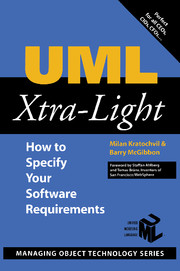Book contents
- Frontmatter
- Contents
- Foreword
- Preface
- Acknowledgments
- About the Authors
- How to Customize This Book
- Chapter 1 Introduction
- Chapter 2 Aligning to the Business
- Chapter 3 Adding Rigor to the Requirements
- Chapter 4 Sketching the Inside Structure
- Chapter 5 Sketching the Inside Dynamics
- Chapter 6 Moving Toward Components
- Chapter 7 Mapping from Classes to Data Models
- Chapter 8 Concluding Remarks
- Some Suggested Readings
- Index
Chapter 7 - Mapping from Classes to Data Models
Published online by Cambridge University Press: 14 October 2009
- Frontmatter
- Contents
- Foreword
- Preface
- Acknowledgments
- About the Authors
- How to Customize This Book
- Chapter 1 Introduction
- Chapter 2 Aligning to the Business
- Chapter 3 Adding Rigor to the Requirements
- Chapter 4 Sketching the Inside Structure
- Chapter 5 Sketching the Inside Dynamics
- Chapter 6 Moving Toward Components
- Chapter 7 Mapping from Classes to Data Models
- Chapter 8 Concluding Remarks
- Some Suggested Readings
- Index
Summary
Data modeling has been covered thoroughly for decades. Like class diagrams, it provides a structural view. Unlike class diagrams, data modeling omits business-level operations that the proposed system will perform. Most often, it also omits some key relationships, such as generalization, despite the fact that various data-model notations for generalization have been around for almost two decades. Because most data models are on a design level, they already take into account some restrictions posed by the underlying implementation technology (data tables).
Strengths
Data models cope well with the data to be stored in the bottom layer of a system. Therefore, data modeling is a technique suitable later on, during design. The mapping to data models enables modern object-oriented systems to use ordinary relational database engines, which are standard in enterprise systems. In practice, brief previews with Database Administrators are a good idea to coordinate legacy and other systems with our models to come. By the time data modeling becomes really interesting in our project, we already have a more technical focus.
Limitations
Data models omit most of the behavior and business logic. Also, what data modelers call constraints or rules typically turns out to mean special data-related ones (such as rules of referential integrity across data tables), whereas UML includes a more versatile and powerful standard for declaring complex business logic, the UML Object Constraint Language (OCL).
- Type
- Chapter
- Information
- UML Xtra-LightHow to Specify Your Software Requirements, pp. 89 - 96Publisher: Cambridge University PressPrint publication year: 2002

